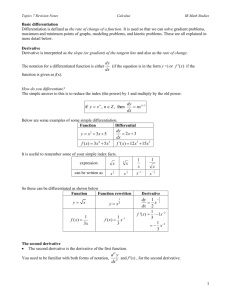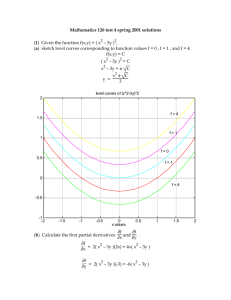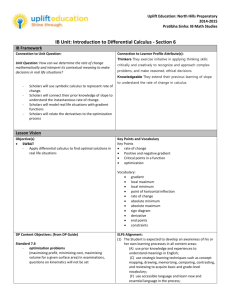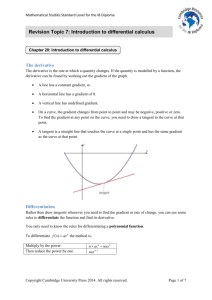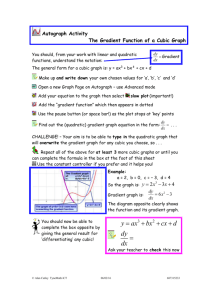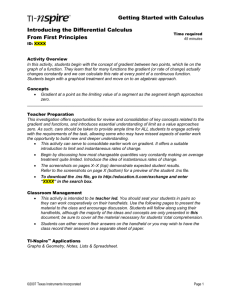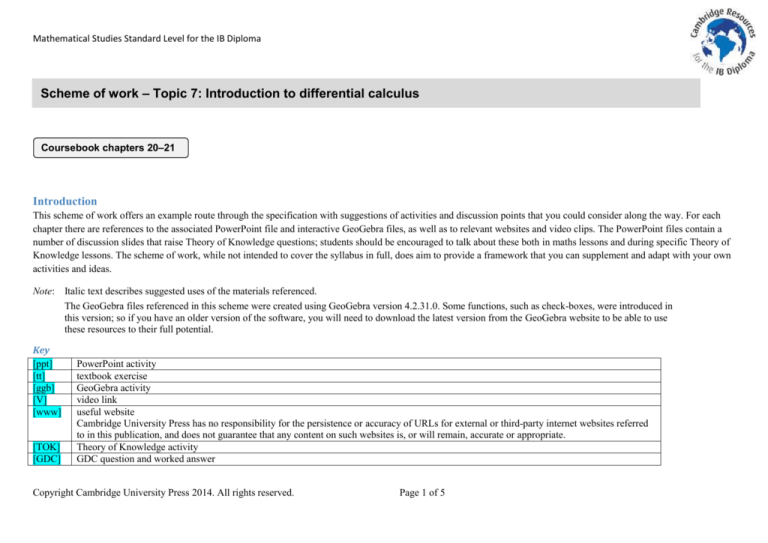
Mathematical Studies Standard Level for the IB Diploma
Scheme of work – Topic 7: Introduction to differential calculus
Coursebook chapters 20–21
Introduction
This scheme of work offers an example route through the specification with suggestions of activities and discussion points that you could consider along the way. For each
chapter there are references to the associated PowerPoint file and interactive GeoGebra files, as well as to relevant websites and video clips. The PowerPoint files contain a
number of discussion slides that raise Theory of Knowledge questions; students should be encouraged to talk about these both in maths lessons and during specific Theory of
Knowledge lessons. The scheme of work, while not intended to cover the syllabus in full, does aim to provide a framework that you can supplement and adapt with your own
activities and ideas.
Note: Italic text describes suggested uses of the materials referenced.
The GeoGebra files referenced in this scheme were created using GeoGebra version 4.2.31.0. Some functions, such as check-boxes, were introduced in
this version; so if you have an older version of the software, you will need to download the latest version from the GeoGebra website to be able to use
these resources to their full potential.
Key
[ppt]
[tt]
[ggb]
[V]
[www]
[TOK]
[GDC]
PowerPoint activity
textbook exercise
GeoGebra activity
video link
useful website
Cambridge University Press has no responsibility for the persistence or accuracy of URLs for external or third-party internet websites referred
to in this publication, and does not guarantee that any content on such websites is, or will remain, accurate or appropriate.
Theory of Knowledge activity
GDC question and worked answer
Copyright Cambridge University Press 2014. All rights reserved.
Page 1 of 5
Mathematical Studies Standard Level for the IB Diploma
Topic 7:
Introduction to differential calculus
18 hours
Aims: To understand that gradient is a function that can be generalised and used to calculate rates of change
To understand and be able to calculate the derivative of a function
To be able to use the derivative to find the optimal solution to a problem
Phase
Chapter 20:
Introduction
to differential
calculus
Estimated
time
allocation
10 hours
Focus from
the text
The derivative
Differentiation
Learning objectives
Activities
Links
Understand the derivative
in the context of gradient
and as a rate of change
[ggb] ch20 gradient quadratic log
This interactive file starts with the simplest of
quadratics and a point P on the graph. As the point is
moved using the slider on the left, its x- and ycoordinates and the gradient of the tangent are logged
in the spreadsheet. This will allow the relationship
between the x-coordinate and the gradient to be
investigated. The sliders on the right can be used to
change the function to more complex forms. The tangent
line, gradient and graph of the derivative function can
also be displayed by ticking the appropriate checkboxes. It is particularly interesting to highlight the static
nature of the derivative line, as compared to the tangent
and gradient which change with the point. Students
should be able to see that the gradients at different
points follow a function.
[tt] Page 581 Exercise 20.1 ‘Finding the derivatives of
simple polynomial functions’
[V] http://www.khanacademy.org
Be able to differentiate
simple polynomial and
rational functions
[tt] Page 588 Exercise 20.2 ‘Further differentiation,
including of reciprocal functions’
Copyright Cambridge University Press 2014. All rights reserved.
Page 2 of 5
/math/calculus/differential-calculus
/intro_differential_calc/v/newtonleibniz-and-usain-bolt
This 9-minute video clip uses the
100-metre sprinter Usain Bolt as
an example to explain why we
study differential calculus.
[www] http://www.mathsisfun.com
/calculus/derivativesintroduction.html
Mathematical Studies Standard Level for the IB Diploma
Rates of
change
Be able to apply the
method of differentiation
to situations involving
rates of change
[ppt] Chapter 20 slides 2–3: Change
For this discussion task, three images are used to
highlight the rate of change as a comparative measure.
It could be used as a short research activity in which
students have to find the rates of change in order to
identify the units and compound measures used.
[tt] Page 592 Exercise 20.3 ‘Using differentiation to find
the rate of change’
The second
derivative
Gradient of a
curve at a
given point
Appreciate that the
differentiation process
can continue and
understand what the
second derivative means
Be able to find the
gradient of a curve at a
specific point, either
manually or by using the
GDC;
be able to find the
coordinates of a point on
the curve given the
gradient
Copyright Cambridge University Press 2014. All rights reserved.
[ppt] Chapter 20 slides 4–5: Turning point
In this task a turning point is defined by asking the
students to fill in what must have happened between a
negative gradient and a positive gradient. Although
short, it highlights a key point in understanding the
nature of curves as characterised by their gradient.
[ggb] ch20 gradient quadratic
In this interactive file you can move the blue point A
along the curve and adjust the coefficients of the
quadratic function using the sliders to see how their
values affect the tangent and gradient at point A as well
as the derivative function. As in ‘ch20 gradient
quadratic log’, you can use the check-boxes to show or
hide the tangent line, gradient and derivative function.
This activity could be used as the basis for an
investigation or to summarise work from the text or
other explorations. It could also be used to assess
understanding during a plenary; for example, you could
define a function using the sliders and ask students to
find the derivative.
Page 3 of 5
[V] http://youtu.be/5QHY0WolfPg
3-minute video clip showing how
to use differentiation to find the
gradient of a curve
Mathematical Studies Standard Level for the IB Diploma
[ggb] ch20 gradient cubic
This file is an extension of the quadratic version,
allowing exploration of how the coefficients of the
function affect the derivative, tangent and gradient of
the curve. The function is displayed and sliders allow
adjustment of its coefficients. Use the check-boxes to
show or hide the various elements as needed.
Equation of
the tangent at a
given point
Equation of
the normal at a
given point
Review of
Chapter 19
1 hour
Exponential
and
polynomial
functions
Be able to use
differentiation to find the
equation of the tangent at
a specific point
Know the relationship
between the gradient of a
normal and the gradient
of the tangent;
be able to use
differentiation to find the
equation of the normal
Secure the skills of
drawing and interpreting
polynomial and
exponential graphs by
undertaking past paperstyle questions
Copyright Cambridge University Press 2014. All rights reserved.
[tt] Page 599 Exercise 20.4 ‘Using differentiation to find
gradients at specific points on a curve and to find
coordinates of points with a specified gradient’
[tt] Page 604 Exercise 20.5 ‘Finding the equation of a
tangent using the GDC’
[tt] Page 607 Exercise 20.6 ‘Finding the equation of a
normal using the GDC’
[ppt] [TOK] Chapter 20 slides 6–7: Zero gradient points
This activity focuses on functions and their variation.
The question of whether a function must have turning
points is an interesting one and could lead to a deep
analysis of the nature of functions or simply an
appreciation that graphs can have simplified versions of
themselves. This links Chapters 20 and 21 and could
easily be used with either chapter.
[tt] Page 567 Mixed examination practice
Page 4 of 5
[www] http://www.dummies.com
/how-to/content/how-to-find-anormal-line-perpendicular-to-atange.html
Summary of non-GDC method for
finding the equation of a normal
Mathematical Studies Standard Level for the IB Diploma
Phase
Chapter 21:
Stationary
points and
optimisation
Estimated
time
allocation
6 hours
Focus from
the text
Increasing and
decreasing
functions
Stationary
points,
maxima and
minima
Optimisation
Learning objectives
Activities
Links
Understand what it means
for a function to be
increasing or decreasing;
be able to determine this
characteristic of a function
from the graph or the
derivative
[ppt] Chapter 21 slides 2–3: Nature of graphs
This provides a graphical summary of the properties of
‘increasing’, ‘decreasing’ and ‘turning point’, and how
these link to the derivative.
[www] http://www.mathsisfun.com
Be able to identify
different types of
stationary points by using
differentiation or the GDC
Understand the link
between optimisation
problems and maxima and
minima of functions;
be able to use the
derivative to find optimal
solutions to problems
[tt] Page 624 Exercise 21.2 ‘Finding maximum and
minimum points using differentiation and the GDC’
[tt] Page 616 Exercise 21.1 ‘Determining when a
function is increasing or decreasing’
[tt] Page 628 Exercise 21.3 ‘Finding the optimal
answer to a problem’
[tt] Page 633 Exercise 21.4 ‘Using differentiation to
find an optimal solution’
Review of
Chapter 20
1 hour
Introduction to
differential
calculus
Secure the skills of
differentiating simple
functions by undertaking
past paper-style questions
[tt] Page 609 Mixed examination practice
Review of
Chapter 21
1 hour
Stationary
points and
optimisation
Secure the skills of
identifying stationary
points and solving
optimisation problems by
undertaking past paperstyle questions
[tt] Page 636 Mixed examination practice
Copyright Cambridge University Press 2014. All rights reserved.
Page 5 of 5
/sets/functions-increasing.html

